I know you’ve been on the edge of your seat hoping for Part 2 of The Quest for the Ideal Carry Revolver. Unfortunately, thanks to nasty winter weather and the past week’s wild ammo market, I haven’t been to the range much lately. So until I get more trigger time with the revolvers I’m trying out, enjoy my best attempt at deciphering Smith & Wesson’s revolver catalog.
We got some good feedback on our reference guide to 1st-3rd Gen S&W Semi-Autos, so for our Wheel Gun Wednesday series I thought I’d put together a similar chart for all of the S&W revolvers. And that’s exactly what I would have done except Smith & Wesson’s revolver model numbers have all been assigned by a mad genius. Sometimes there appears to be a logical numbering system at work, but it’s applied inconsistently, and varies from one product line to the next.
So instead of one big comprehensive chart for every Smith & Wesson revolver ever made, I’m offering this smaller bite-sized chunk: every post-1957 .38 Special and .357 Magnum revolver from S&W that officially entered full-scale production.
Why 1957? That’s the year when S&W switched over to assigning model numbers to each revolver rather than identifying them only by unique names (e.g., “Registered Magnum” or “Combat Masterpiece”). The nicknames still remained in many cases, but they could refer to a family or series of revolvers with similar characteristics.
In the charts below, I’ve grouped the models by frame size and then by series. Where possible, I’ve listed the defining features of each series. For each model, there’s information about its caliber, frame material, sights, finish, and ammo capacity. Here’s a handy key for how to read the chart:
Series Name: Some of these names were used in the actual S&W catalog but others are just nicknames. S&W stopped using some of these names, even when production of the model continued. For example, the “Military & Police” designation was dropped from the K-frame revolvers years ago (and recycled for their polymer semi-autos and AR rifles), but I’ve kept the designation in the chart for all revolvers that fit the original M&P criteria.
Series Features: Each series is identified by some unique features that don’t typically apply to other models of that frame size.
Caliber: For this post, all models are .38 Special or .357 Magnum. Most S&W .38 Special revolvers can handle +P ammo, but the +P designation doesn’t appear on the barrel of some older models so it’s always best to contact S&W customer service and verify that it’s safe.
Frame Material: S&W has used a variety of metals to construct their revolvers over the years but the frames all have been either steel or a lightweight aluminum alloy. Some variants of the alloy guns contain Scandium for an even lighter overall weight. The absolute lightest S&W revolver have also included a Titanium cylinder. I’ve noted the use of Sc or Ti on the chart when the only available version of a given model use those alloys. Other alloy frame guns listed on the charts may have Sc frame or Ti cylinder variants that exist in addition to the standard aluminum or steel versions.
Model Number: The model number assigned to the product without any prefixes or suffixes (with the exception of the “Plus” model L-frames).
Sights: Sights can be fixed or adjustable. The fixed sights are generally a ramp style front sight with a gutter in the top strap to form the rear sight. S&W has used a variety of adjustable rear sights over the years, but most have a removable blade insert. Front sights on models with the adjustable rear can be the traditional ramp style machined into the barrel, but newer front sights are pinned, and can be removed and replaced with aftermarket front sights.
Finish: For the sake of simplicity, I’ve only used the labels “black” or “stainless” on the chart. Black can refer to a matte black finish or a glossy blue finish. Older models with a blue finish were often also available with a shiny nickel plated finish. Stainless can refer to the polished or matte stainless steel revolvers, or alloy revolvers with a silver matte finish that mimics the stainless steel look.
Ammo Capacity: All J-frame .38 Special and .357 magnum revolvers have a five-round capacity. K-frames all have six. L-frames can hold six or seven shots depending on the model. Older N-frame designs have a six-round capacity but the newer ones hold eight.
Other Info: I’ve tried to keep the chart as complete as possible while still being readable. That said, there is still information you won’t be able to find here. The most significant omission is barrel length. Almost every model has been offered in multiple barrel lengths at some point but availability varies. The more common barrel lengths are listed in the summary for each frame size.
I also haven’t listed the variants available for each model. If a model number contains a suffix like “PD” or “Lady Smith”, it might mean that it has features that distinguish it from other models in the same series. Here’s an incomplete list of the more common variants and some other suffixes you might see on model numbers:
- PD: “Personal Defense”. Usually indicates Scandium alloy frame.
- Sc: Indicates frame with Scandium Alloy.
- Ti: Titanium Cylinder. Usually accompanied by Scandium alloy frame.
- Lady Smith: Name given to a number of variants in different calibers and frame sizes. Usually accompanied by special grips and engraving.
- Airweight: Indicates an Aluminum alloy frame.
- Airlite: Indicates a Scandium alloy frame.
- Night Guard (NG): Series introduced in 2008 with models in various calibers and frame sizes. All have a 2.5-inch barrel, alloy frame, steel cylinder, Tritium front sight, and a removable Cylinder and Slide brand fixed rear sight.
J-Frame
The J-frame S&W revolver has become so ubiquitous that the term is often used as a generic reference to almost any small frame snub nosed revolver. The most common barrel length for a J-frame is 1 ⅞” but 3-inch models are also plentiful along with some other less common sizes.

J-Frame model numbers are determined by frame material, hammer/action type, and finish. Unlike K and L frame revolvers, S&W doesn’t use a separate model number for J-frames with adjustable versus fixed sights.
A few J-frame models started out as being offered in only .38 special, but in the mid-1990s, were beefed up to handle .357 magnum. I’ve included each of these multi-caliber models as two separate entries in the chart.
The three major J-frame model series are as follows:
- Chief’s special: Standard hammer. Most have fixed sights but a few have been offered with adjustable sights.
- Bodyguard: The original S&W Bodyguard. They include a hammer shroud with a small protrusion that allows the user to cock the hammer for single action shots.
- Centennial: This is the name generally given to all “hammerless” S&W revolvers. They aren’t literally hammerless, but the hammer is completely internal, which means these revolvers can only be fired in double action.
K-Frame
The classic S&W K-frame is one of Smith & Wesson’s most enduring designs. Picture a typical 20th century policeman’s “service revolver” and it probably looks a lot like a K-frame with a 4-inch barrel. These mid-size revolvers have also been offered with long 6-inch barrels for target models, and 3-inch, 2.5-inch, and 2-inch snub nose versions for concealment.

Model numbers are based on finish, caliber, and whether the gun has fixed or adjustable sights.
There have been three major series of .38 Special and .357 magnum K-frames along with a couple of unique models:
- Military & Police: The original K-frame. They have fixed sights and no underlug or shroud around the ejector rod. The .357 magnum versions were added to the catalog along with the Combat Magnum series.
- Combat Masterpiece: Essentially identical to the M&P line, but with the addition of adjustable sights. The model 68 — a special run for the California Highway Patrol — also includes a shrouded ejector rod.
- Combat Magnum: These are the .357 versions of the Combat Masterpiece. The Combat Magnums have a shrouded ejector rod as standard.
- Target Masterpiece: Target guns with adjustable sites and typically offered with a 6-inch barrel, but also available with 4-inch and 8 ⅜-inch barrels. The later models added a full underlug to the barrel.
- Alloy K-frames: The only non-steel K-frame revolvers have been the 12 and 315. The Model 12 was offered for many years as a lightweight version of the model 10, but was discontinued in 1986. The 315 was offered for a very short time in 2008 as a part of the Night Guard series with a 2.5-inch barrel and upgraded sights. By some estimates, fewer than 1000 were ever produced.
L-Frame
The medium-large L-frame .357 models came along in the early 1980s as a bridge between the hefty N-frames and the smaller K-frames. Common barrel lengths are similar to the K-frames, with the 4-inch models being the most common and 6-inch, 3-inch, and 2.5-inch versions also available.
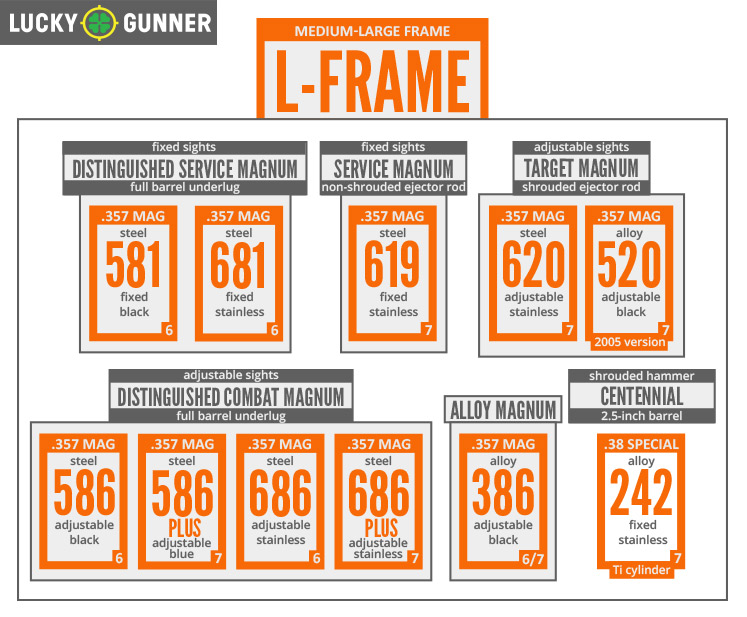
Also similar to the K-frame revolvers, the L-frame model numbers are determined by sights, finish, and frame material.
S&W has used the L-frame for a lot of its more innovative and experimental models. The 586 and 686 “plus” models were among the first 7-shot medium-frame revolvers on the market, and several lightweight alloy L-frames have been produced at various times.
- Distinguished Combat Magnum: These are the flagship models of the L-frame line. They feature a full barrel underlug, steel frame, and adjustable sights.
- Distinguished Service Magnum: Nearly identical to the Combat Magnum, only with fixed sights.
- 619 & 620: These two were introduced as a replacement for the K-frame .357 models that S&W discontinued in the early 2000s. They are very similar to the 681/686, but have a slimmer barrel profile with a shrouded ejector rod rather than a full underlug.
- 520: Not to be confused with the short-lived N-frame model 520. This was essentially an alloy framed version of the 620.
- 386: The model with no name. There have been several versions of the 386, each with its own name and features. The common attributes are an alloy frame with a black finish and adjustable sights. With the exception of the 386 PD, all have had a 7-shot cylinder.
- 242: The only “Centennial” hammerless Smith & Wesson that’s not a J-frame. Designed for concealed carry, it’s also the only L-frame chambered in .38 Special rather than .357 Magnum.
N-Frame
The S&W Model 27 N-Frame was the original platform for the .357 Magnum cartridge. The design proved to be durable, but it’s considered large and heavy for a 6-shooter by today’s standards. With modern metals, S&W has managed to cram eight rounds into the newer N-frame .357s.

Available barrel lengths for N-frame revolvers have varied widely over the years, and include 3 1/2-inch, 4-inch, 5-inch, 6-inch, and 8 3/8-inch models, among others.
- The Original Magnums: The Model 27 was the original .357 and was initially called the “Registered Magnum”. It has a deep blue finish, shrouded ejector, and adjustable sights. The budget model 28 “Highway Patrolman” has all the same features, but with a few minor changes, such as a slightly less polished finish.
- 8-Shot Magnums: Neither the alloy 327 or the steel 627 have had an official name. Both of these 8-shot N-frames have been offered with various features and barrel lengths.
- Military & Police: In 1980, the New York State Police ordered a model 27 with fixed sights. The ordered was never delivered, and a few thousand of these ended up in the general market. In 2005, S&W recycled the model number 520 for an alloy L-frame .357.
Work in Progress
I am by no means an expert on Smith & Wesson revolvers. Most of this information is just stuff I’ve picked up from window shopping for Smith & Wesson revolvers over the years. I’ve tried to verify and flesh out the info using other sources like the Standard Catalog of Smith & Wesson, but there are probably some omissions and errors in there somewhere. If you spot one, be sure to let me know. I’ll be checking on this post periodically and will update it with corrections and additions when I have the chance.
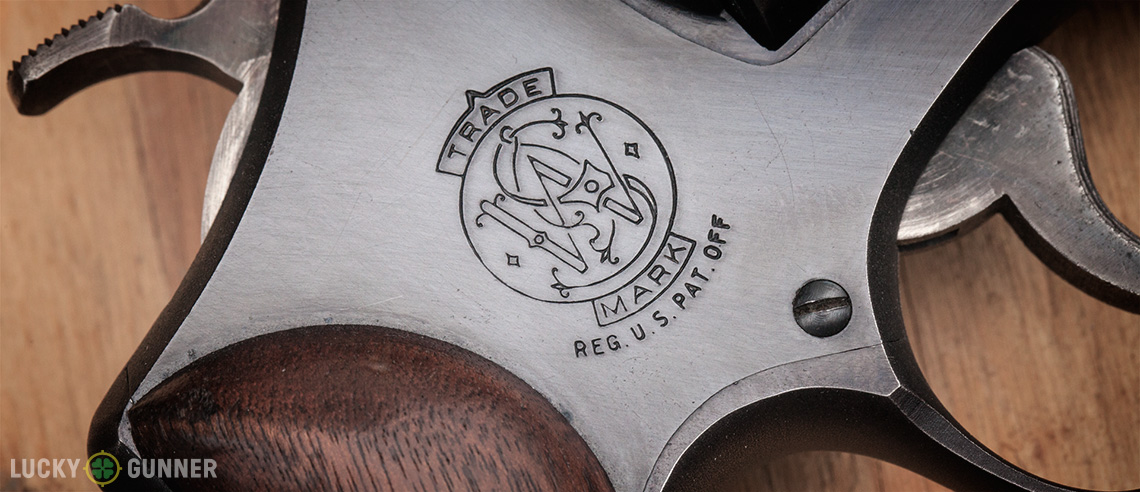


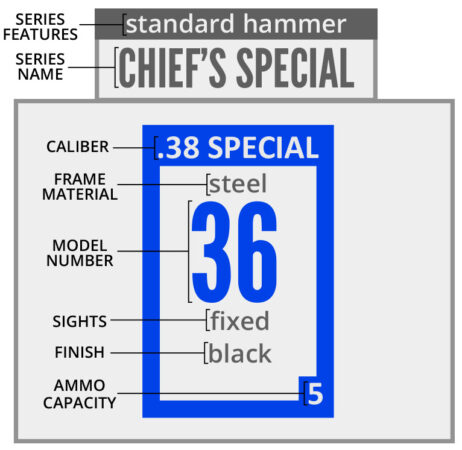
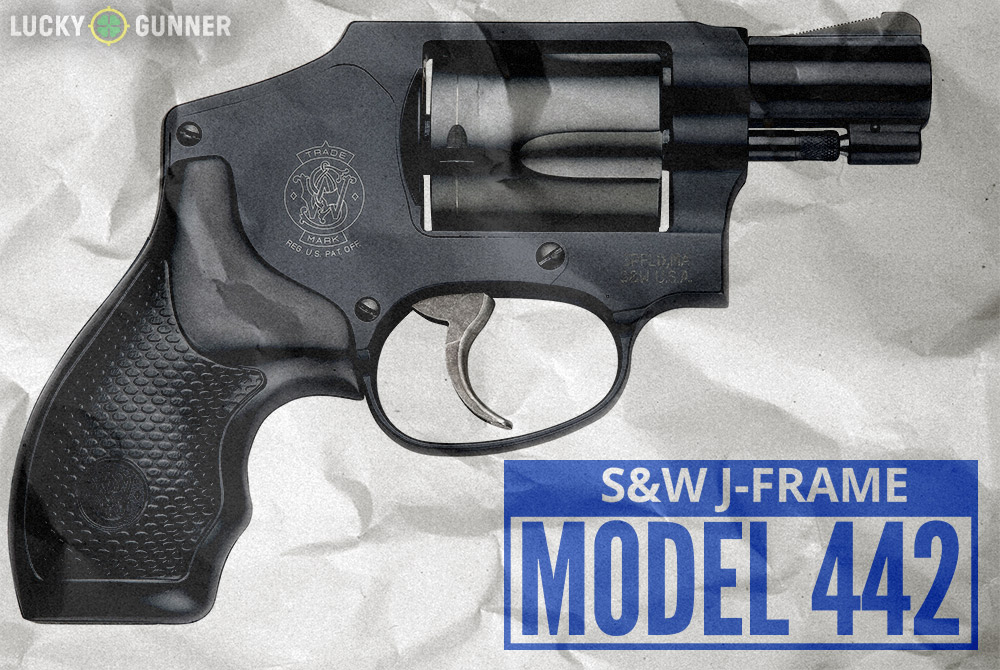
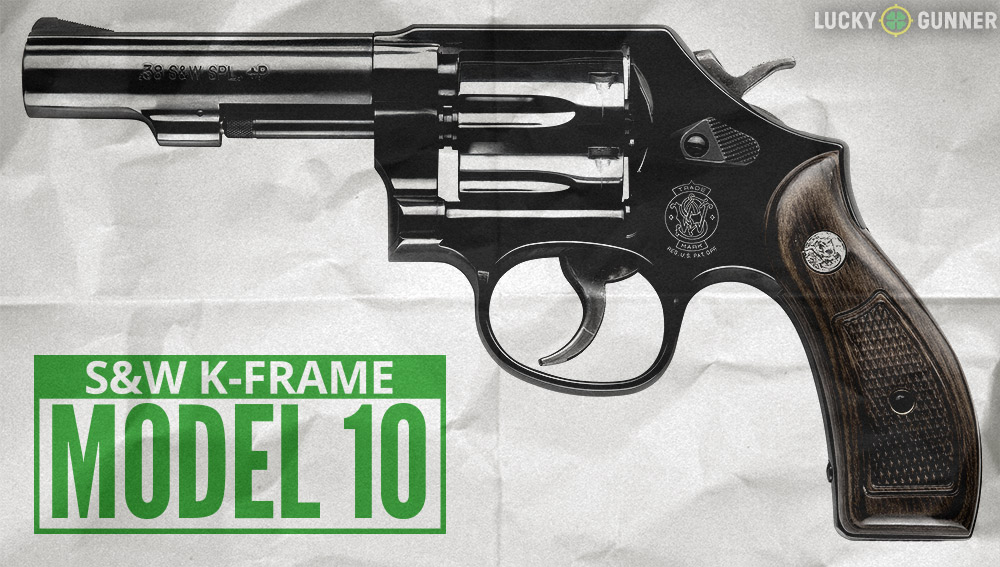
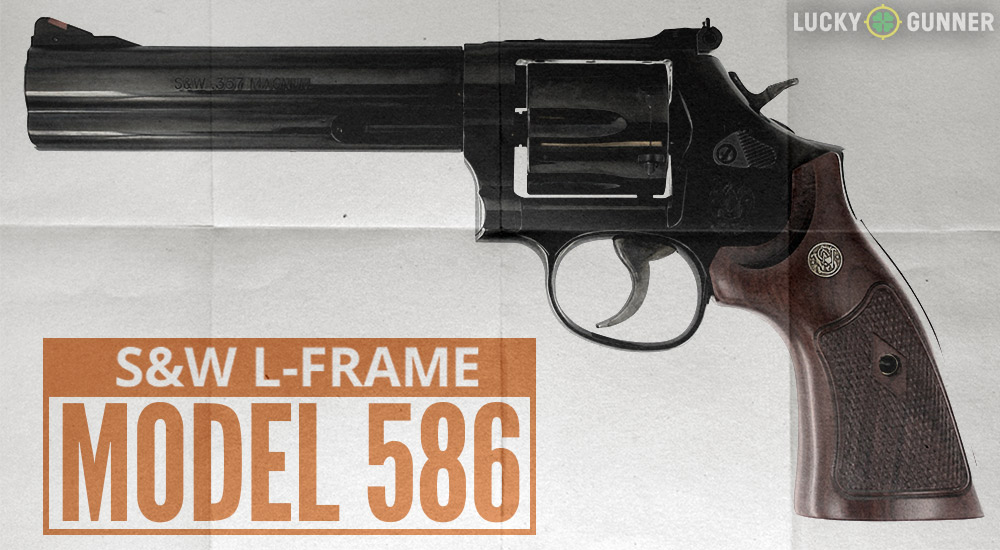
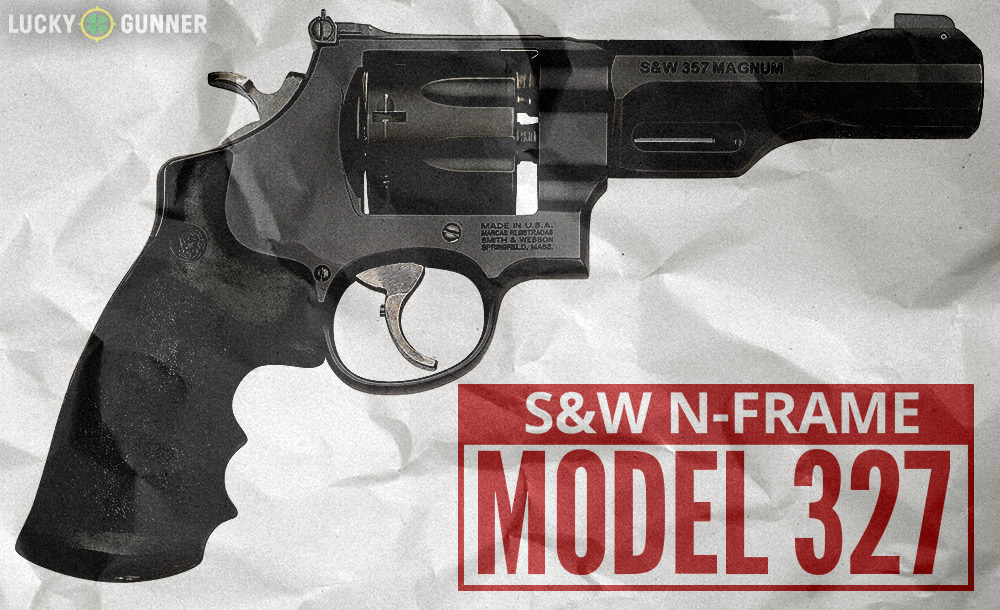
Nice article. One correction (well, 2) the Combat Magnum series (Models 19 & 66) are chambered in .357 Magnum.
Whoops, you’re right. Not sure how that slipped past me… I’ve got a 66 sitting two feet away from me right now.
Yeah John mentioned that the Model 19 is a .357… Detroit PD model 10’s came in nickel, not sure if other model 10’s were offered that way. I believe the 19 also was offered in nickel, but may be totally wrong there… I’ve seen some sold as original nickel though I do believe. I think finish options may be off for that reason on a few of these (offered in more than one finish in the same model).
Nevermind, saw the explanation on the finishes… ignore my bit about that! Missed it somehow in the explanation, the 19 is indeed a .357 though :).
Thanks, I must have had a brain fart. I’ve corrected the caliber for the 19 and 66.
19s certainly do come in nickel. Have 2 1/2, 4, and 6 inch in nickel in the safe. I occasionally still carry the 2 1/2″. My favorite revolver ever.
I do have a model 10 nickel from the DPD. 4inch, pencil barrel.
Another great article Chris. Thanks.
My daily carry is a Model 60 Stainless in .357. Your chart says it has adjustable sights. Not mine. Front sight is a pinned blade but the rear has the groove running along the top of the frame.
You’re right, the newer Model 60s have been offered with both fixed and adjustable sights. I’ll make that change on the chart.
I love my 686 plus L frame. It is my bedside weapon.
Mine says “Highway Patrolman”. Is there a conversion chart to model numbers?
The Highway Patrolman is the Model 28. If the revolver was made after ’57, you can find the model number on the frame. Just open up the cylinder and look on the part of the frame that would normally be covered by the crane (the part of the frame in front of the cylinder). You should see a model number and then probably a dash and another number that indicates which variant (e.g., “28-2”).
That would be a model 28, excellent revolver…hope you have the 6″ with combat grips …good shooting.
Is there a serial # identification sight somewhere on the internet? I would like to get a manufacturing date for my model 19.
There’s no site that I know of, but the Standard Catalog of Smith & Wesson can usually tell you. Email me your serial # through the blog’s contact form and I’ll look it up.
AAW3873, Thanks for your help.
Looks like sometime in late 1982.
Thanks for your help, have a great day.
Hey LG Chris. You seem pretty knowledgeable with these guns. My father in law left me his S&W .38 air weight, in fantastic condition. Anyway, how do I find the year on this gun. The original instruction booklet in the box has the year 1955 stamped on it, but that could be the generic year for that booklet. The serial number is J42428. Thanks
Assuming it’s a Model 37 or 38, it was made in 1969 or 1970.
It is a model 38. I also called Smith and Wesson and they verify that it is a 1969 or 1970 model. You do know what you are doing. Thanks for your response.
I have a 4″ s.s 686 got it on my 21st Birthday going to be 52 on the 25th stiil good to go
You missed the L frame 44 spc models
This is awesome! I’ve been looking for a secret S&W decoder ring for a while. Good job guy!!
I had the 38 Special K frame stainless and reamed the it to hold 357 rounds. This was a smooth trigger stainless, unlike many others. Then I had highest grain reloaded ammo from the gunsmith. The thing was loud and flames shot out of the barrel, many times hearing protection or not the range would empty.
S&W Governor. “Z” frame. 6 shot. 2.5 inch barrel? Caliber is .410 shotgun, .45ACP, and 45 long colt. Tritium front sight. Scandium alloy.
Why limit to just .38 Special / .357 Magnum?
Larger calibers can be used as hideout guns, too.
Q. Like so many others in quest of S&W ser#, I happened upon your site. I have an older revolver (6 shoot) from nypd, ser# n55581. She’ a beauty. Just looking for an approx DOB. Any ideas?
HI Kat, can you give the model #? That will help.
If it is former NYPD it’s most likely a model 10. This was the standard issue handgun for most officers on the line.
Jim Cirillo carried two, surviving 14 gun battles while serving on stakeout teams, facilitating his “New York reloads”.
DID I MISS SOMETHING IN THE GUIDE? WHAT ABOUT THE MODEL 29? OVERALL A VERY GOOD GUIDE. ALSO, A FEW MODEL 10,s (10-6 I believe) WERE CHAMBERED IN 357 MAG.
THANKS
The Model 29 is a .44 magnum. This guide only covers .38 spl and .357 mag models.
THANK YOU- I GUESS I HAVE A TOUCH OF OLD-TIMERS DISEASE.
I am thinking of buying a gun that my dad’s had since the mid 80s. It’s stamped as a model 26-2, and its also marked as a “highway patrolman” on the barrel. Chambered in 357 magmum. I can’t find any info on a 26, as a 45 acp. Can you tell me what I might have? Thanks.
I have a 342, and while is lighter than the scandium j frames I do not believe that it is truly a scandium framed gun.
Can you tell me where the ‘dash’ number is located on the Smith & Wesson Bodyguard .38 Special?
This photo shows where you can find the full model number on most S&W revolvers:
http://www.smith-wesson.com/wcsstore/SmWesson2/upload/images/safety/329recall.jpg
I know where the serial number and model numbers are but i am looking for the ‘DASH’ number. Can anyone help with this?
The “dash number” is the part of the model number that appears after the dash. So, for instance, if your model number is 60-7, that means the dash number is 7. It’s the 7th version of the model 60. If there’s no dash after the model number, then it’s the original version of that model, usually referred to as a “no dash” model.
Thanks Chris. That is a big help, in case I need to have warranty work done. Which will probably not be needed, but at least I will have the info, should that ask. My model number did not have a dash.
i confused the numbers on mine are ccd7069 what the heck does that mean. This was my dad’s 357 hammerless. What model would it be, any ideas
That looks like a serial number rather than a model number. The photo below in my reply to “LuckyLady” shows where to find the model number for S&W revolvers made after 1957. It should be a two or three digit number and may or may not be followed by a dash and a one or two digit number.
Thanks lg Chris I couldn’t find any dash the only 3 digit number was 894. I also found a 5 digit number. I think its a J frame but not sure.
I just sent you an email… might need some photos to help with this one.
I resently bought an old 57 Mag S&W model # 65-1 can you tell me anything about this gun! Also there are Numbers engraved under barrel on frame. Thanks. Don
What would you like to know? The 65 is a fixed sight .357 K-frame, which means it’s a great revolver. Do the engraved numbers appear to be from the factory, or done by a previous owner? A lot of police and corrections departments and security companies used these revolvers and sometimes they etched their own numbers on the frame.
I have a Smith &Wesson mod10 but under the model is 15-2 do you know what this means also the 10 is strange looking almost could be read as 11
Does it have adjustable sights? If so, it’s a model 15.
Hello I have found a S&W 686 the gentleman tells me it’s an hunter classic is there any way of telling.
I have a .357 I received from my father in law. He bought the gun years ago and can’t remember anything about it, it there a way to tell when it was made from the serial number?
I have a model 19-5 I believe I know where the serial number is. Right above the model number. But my question is below that there are a couple more sets of numbers, One says B19 and the other says 11818. What do these decode or mean? The numbers at the bottom of the picture. How do I find out what year it was built?
Thanks for all and any help.
R
No idea what the other numbers are. The number above the model number is the serial number. According to the Standard Catalog of S&W, the AAW pre-fix puts it in late 1982, which is the first year of the -5 model 19. The B19 looks like it may have been added after it left the factory, maybe by a police or corrections dept, or security company. But it could be a factory mark, to… I’m far from an expert on these things 🙂
Ahh Okay thanks
I have a Model 60 (no dash) serial number R25273. Can you give me an idea on date of manufacture?
I enjoy your site very much. Very informative.
Thanks
Tim
I have a model 60 (no dash) stainless steel 38 spl the only numbers I can find are below the model # and again under the grips (same #s) is this the serial # or am I missing something, where should I be looking? this is a 5 digit # I am looking at no letters.
What a fantastic resource. Thanks so much for assembling this.
Chris, I have a model 60 with a serial number R85792. could you tell me the year and or anything else Ithe serial number reveals about this gun
I am trying to find out information about my Smith & Wesson 38.8. & W.OTG it only has two numbers on it that I know of and PATD dates on the top of the barrel.
Thanks
Very informative article. I inherited a L-frame from my father-in-law. Thanks to you I was able to identify the frame. My question to you is whether I have to change cylinders in order to shoot .38 and the .357 mag?
I just picked up two smith revolvers from an auction. Both had the serial and model number on the yoke ground off. ATF said they are ok because the serial number are untouched on the bottom of the handle. Is there anyway to find out the model numbers based on the serial number. One starts 53KXXXX, the other is ACYXXXX. Both are real nice 357 Mags with 4″ barrels.
I just ran across a S&W that I have questions about. The model number is 48287. No letters. Barrel may be 2″. Nickel plated, fixed sights, “Made In USA” under cylinder on right, S&W logo on right also…none on left. The word ENGLAND is stamped on the cylinder which holds 6 rounds. All numbers match. The ejector is not shrouded. The fellow that owns it, thinks it’s a .357 that he got on a trade. It doesn’t look stout enough for that kind of round. Any ideas?
I HAVE A 38 SPECIAL 6″ BARREL PAT #1884 THRU 9-19 1909 ser # 192469 ser # 192469
I have a S&W 38 spl CTG marked on side, and Smith & Wesson, on 5″ Barrel s/n 429533 looks like 6I590 on swingout or 61590 how do i find info on it ?
My father gave me a s&w 38 special ctg. Model 10-7 , when I pull the hammer back it does not stay back , is this normal for the model and does that make it a single action fire ? I
I believe that makes it a Double Action Only. Single Action requires the hammer to be pulled back and cocked each time. Early revolvers were single action–which must have seemed no inconvenience at all compared to reloading each shot–but Double Action revolvers were later invented to allow the gun to be fired without cocking the hammer first. Most revolvers allow both single and double action. These qualities can be altered by replacing or altering the hammer and/or the trigger parts.
Matthew, thank you for your quick response, I’m new to revolvers and guns in general, yet am trying to learn as much as I can about mine and other future purchases. I plan on taking the 38 out for some target practice, and wanted to be sure everything was as it should be before doing so. Thanks again!
I have a S&W model 15 serial # aud0085 can anyone tell me when it was made?
My favorite are the “ssr pro 357/38″ sweet 4” And if you go small the m63 are awsom. Revolver’s from S&W are absolutely the best way to go if you want a revolver. Nothing over nothing beside! Purely quality! Sorry Ruger ,Taurus that’s is the fakt..
My dad before he passed gave me a 357 Magnum with the serial number AFL 9968. Anyone have any info on it?